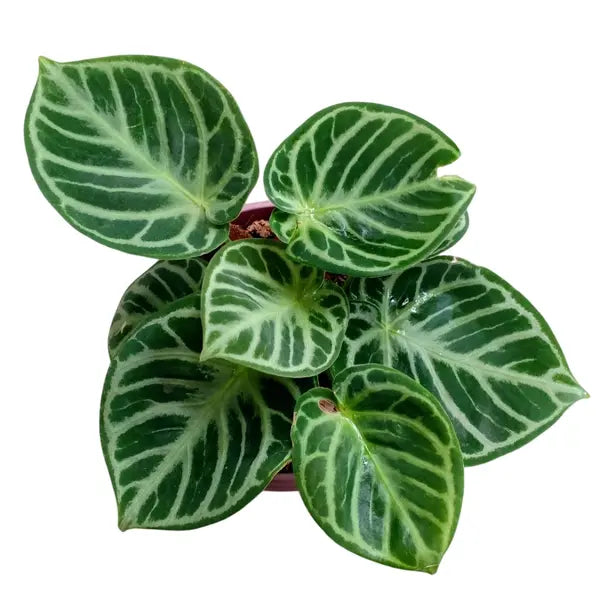
Anthurium Dorayaki
Selling Size : Single Plant | 4" Pot Included | Secure Packing
Anthurium Dorayaki is a popular hybrid known for its striking, thick, rounded, velvety leaves with prominent silver venation.
Here's a detailed care guide for Anthurium Dorayaki :
1. Light:
Bright, Indirect Light is Key: This is crucial for Anthurium Dorayaki. It loves bright spaces but direct sunlight will scorch its delicate velvet leaves, leading to browning or yellowing.
Ideal Placement: An east or north-facing window is often perfect. If you have a south or west-facing window, use sheer curtains or blinds to filter the intense light.
Signs of Too Much Light: Yellow or brown leaves, curled edges, thinning or wilting foliage, or small translucent spots on leaves.
Signs of Too Little Light: Poor growth and a lack of new leaves.
2. Watering:
Consistent Moisture, Not Soggy: Anthurium Dorayaki prefers consistently moist soil, but absolutely hates sitting in water. This is to prevent root rot, which is a common issue.
When to Water: Water thoroughly when the top 1-2 inches (or 10-15%) of the soil feel dry to the touch.
Drainage is Essential: Always ensure your pot has drainage holes, and empty any excess water from the saucer.
Frequency: This can vary depending on your environment, but generally, about once a week is a good starting point. Adjust based on how quickly your soil dries out.
3. Humidity:
High Humidity is a Must: Being a tropical plant, Anthurium Dorayaki thrives in high humidity, ideally above 60%. Low humidity can lead to browning leaf tips.
How to Increase Humidity:
Humidifier: This is the most effective way to maintain consistent high humidity.
Pebble Tray: Place the pot on a tray filled with pebbles and water, ensuring the bottom of the pot doesn't sit in the water.
Grouping Plants: Grouping your Anthurium Dorayaki with other plants can create a microclimate with higher local humidity.
Terrarium or Grow Cabinet: For optimal conditions, especially if your home is very dry, consider a dedicated grow cabinet.
Misting: While misting can provide temporary humidity, it doesn't replace consistent higher levels and can sometimes encourage fungal issues if done excessively without good air circulation.
4. Temperature:
Warm and Consistent: Maintain temperatures between 18-24°C (65-85°F).
Avoid Extremes: Protect your plant from cold drafts, sudden temperature drops, and temperatures below 15°C (60°F), as these can damage the plant.
5. Soil:
Well-Draining and Aerated: Anthuriums are often epiphytic in nature, meaning they grow on other plants, not in dense soil. Their roots need excellent airflow.
Recommended Mix: A chunky, breathable mix is ideal. Consider a blend of:
Orchid bark (50%)
Perlite (20-30%)
Coco coir or peat-free compost (30-40%)
Some growers also add charcoal or vermicompost for added benefits.
6. Fertilizing:
During Growing Season: Feed every 4-6 weeks during active growth (spring and summer).
Type of Fertilizer: Use a balanced liquid fertilizer (e.g., 20-20-20 or 10-10-10) diluted to 1/4 or 1/2 strength. A high-phosphorus fertilizer can encourage blooming if that's a goal, though Dorayaki is primarily grown for its foliage.
Avoid Over-fertilizing: Too much fertilizer can damage the plant. Pause feeding during the winter resting phase.
7. Repotting:
When to Repot: Anthurium Dorayaki prefers to be slightly root-bound. Repot only when necessary, typically every 1-2 years, or when roots are visibly outgrowing the pot.
Size: Choose a pot that's only slightly larger than the current one.
8. Pruning:
Minimal Pruning: Remove any yellow, dead, or damaged leaves as they appear to encourage new growth and maintain aesthetics. Pinch them off at the base or use sterile pruners.
9. Pests and Diseases:
Common Pests: Watch out for spider mites, mealybugs, and scale insects.
Treatment: Treat infestations early with insecticidal soap or neem oil. Good air circulation can help prevent pest issues.
10. General Care Tips:
Leaf Cleaning: Gently wipe the velvety leaves monthly with a damp cloth or microfiber gloves to remove dust, which can interfere with photosynthesis and diminish their beauty.
Support: Younger plants may benefit from light staking to help support their upright growth as new leaves emerge.
Acclimation: When bringing a new Anthurium Dorayaki home, give it time to acclimate to its new environment. Younger plants tend to adapt more readily.
By providing these ideal conditions, your Anthurium Dorayaki should thrive and showcase its stunning foliage!

